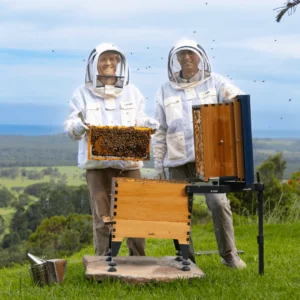Introduction
Welcome to The Beekeeper blog series! In this first post, we’ll help beginners set up their very first hive—covering essential tools, safety tips, and a weekly routine to keep your bees happy and productive.
1. Choosing the Right Hive
Start with a common Langstroth hi

ve, favored by beekeepers worldwide for its modular design and harvest ease.WikipediaShutterstock+8Better Homes & Gardens+8Treehugger+8
2. Essential Gear for the New Beekeeper
- Protective veil or bee suit
- Hive tool, smoker, bee brush
- Simple gloves and sugar spray
Having the right gear helps calm the bees safely.Treehugger
3. Acquiring Your Bees
Order about 10,000 bees with a healthy queen—typically packaged in a screened box. Plan before spring to ensure good apiary establishment.
4. Installing Your First Colony
- Remove a few frames to make room.
- Shake or spray bees lightly with sugar water.
- Place the colony in the brood box and replace frames gently.
This calms the bees and encourages them to settle.oakleyfamilyapiaries.com+15Better Homes & Gardens+15Serious Eats+15
5. Initial Feeding & Maintenance
Provide sugar-water feed (2:1 ratio) until natural nectar is sufficient. Continue weekly checks for healthy brood patterns, pests, and moisture control.
6. Beekeeper’s First-Week Routine
| Day | Task |
|---|---|
| 1 | Inspect hive structure |
| 3 | Check for signs of queen establishment |
| 5 | Monitor food stores and behavior |
| 7 | Prepare for upcoming weather and feed if needed |
Conclusion
This first post positions you as The Beekeeper—ready to nurture a thriving hive. With proper setup and attention, you’ll be off to a great start. Stay tuned for tomorrow’s post: “The Beekeeper’s Safety Measures Around Bees.”

